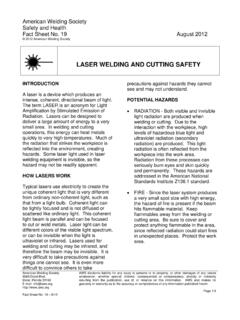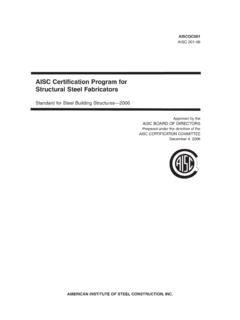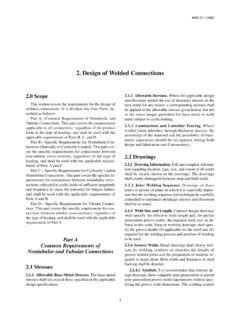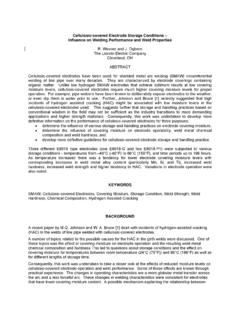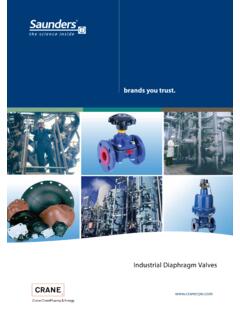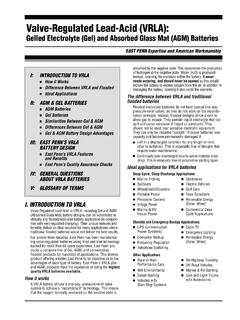Transcription of Passivation of Stainless Steel - American Welding Society
1 Passivation OF Stainless STEELMETAL FINISHING SOLUTIONS BEYOND THE SURFACEPASSIVATION OF Stainless STEELP assivation of Stainless SteelGetting the Properties You've Paid Forby Dan Englebert, Vice President Technical ServicesImagineering Enterprises, conversation usually starts out something like this: Hey, this is Joe from Joe'sMachine Shop. We've got a job in here we're working on and the customer wants us tohave some kinda passivate coating something-or-other. You guys do that? How thick isthat stuff? Is that like some kinda plating or paint or something? What color is it? Howmuch tolerance should I allow for it? Usually, the opening statement ends with aphrase like, I don't even know why they need it. What's the point of using stainlesssteel if your gonna put some kinda coating on it anyway?
2 The fact of the matter is, Joe is not the exception. Many machine shops, purchasingagents, and engineers alike are somewhat in the dark when it comes to the relationshipbetween corrosion resistant ( Stainless ) Steel and chemical Passivation . Even among themetal finishing community, there is some disagreement about the theory behind theprocess of chemical Passivation . Some believe it is effective because it is a cleaningprocess. Others credit the enhanced corrosion resistant properties to the thin,transparent oxide film resulting from chemical Passivation . Regardless of the argu-ment, the bottom line is, it works! Verification tests, including copper sulfate immersion,and accelerated corrosion tests, such as salt spray, high humidity, and water immersion,undisputedly confirm the effectiveness of chemical Passivation .
3 Advanced material engi-neers in aerospace, electronics, medical, and similar high-tech industries have utilizedchemical Passivation for many years. Their applications demand the maximum perform-ance from components manufactured from corrosion resistant ( Stainless ) steels, andthey realize that Passivation is one of the most effective methods of achieving thedesired is Passivation ?According to ASTM A 380, Passivation is the removal of exogenous iron or iron com-pounds from the surface of a Stainless Steel by means of a chemical dissolution, mosttypically by a treatment with an acid solution that will remove the surface contaminationbut will not significantly affect the Stainless Steel itself. In addition, it also describes pas-sivation as the chemical treatment of a Stainless Steel with a mild oxidant, such as anitric acid solution, for the purpose of enhancing the spontaneous formation of the pro-tective passive film.
4 In layman's terms, the Passivation process removes free iron contamination left behindon the surface of the Stainless Steel as a result of machining and fabricating contaminants are potential corrosion sites which, if not removed, result in prema-ture corrosion and ultimately result in deterioration of the component. In addition, thePASSIVATION OF Stainless Steel Passivation process facilitates the formation of a very thin, transparent oxide film, whichprotects the Stainless Steel from selective oxidation (corrosion). So what is Passivation ? Isit cleaning? Is it a protective coating? In my opinion, it is a combination of both!How is the Passivation Process Performed?The process typically begins with a thorough cleaning cycle. It is intended to removeoils, greases, forming compounds, lubricants, coolants, cutting fluids, and other undesirableorganic and metallic residue left behind as a result of fabrication and machiningprocesses.
5 General degreasing and cleaning can be accomplished by a variety of com-monly accepted methods, including vapor degreasing, solvent cleaning, and alkaline removal of the organic and metallicresidues, the parts are placed into theappropriate Passivation solution. Althoughthere are many variations of passivatingsolutions, the overwhelming choice is stillthe nitric acid based solutions. Recently,there has been substantial research per-formed to develop alternative processesand solutions that are more environmen-tally friendly, yet equally effective. Althoughalternative solutions containing citric acidand other types of proprietary chemistryare available, they have not been as widely accepted commercially as nitricacid based three major variables that must be considered and controlled for the passivationprocess selection are time, temperature, and concentration.
6 Typical immersion timesare between 20 minutes and 2 hours. Typical bath temperatures range between roomtemperature and 160 F. Nitric acid concentrations in the 20% to 50% by volume rangeare generally specified. Many specifications include the use of sodium dichromate in the Passivation solution, or as a post Passivation rinse, to aid in the formation of achromic oxide film. Careful solution control, including water purity , ppm (parts per million) of metallic impurities, and chemical maintenance, is crucial for type of Stainless Steel being processed is the determining factor when selecting the most effective Passivation process. Bath selection (time, temperature, and concen-tration) are all a function of the type of alloy being processed. A thorough knowledge of the material types and Passivation processes is paramount to achieving the desiredresults.
7 Conversely, improper bath and process selection and/or process control willproduce unacceptable results, and in extreme cases, can lead to catastrophic failure,including extreme pitting, etching and/or totaldissolution of the entire salt spray test per ASTM Passivation on the left and without onthe OF Stainless STEELE quipment and PrecautionsPassivation should only be performed by trained, experienced technicians familiar withthe potential hazards associated with the science. Safety practices must be fully under-stood when handling Passivation chemicals. Special boots, gloves, aprons and othersafety equipment must be utilized. Tanks, heaters and ventilation, as well as basketsand racks, must be appropriately engineered to perform the process.
8 Iron or Steel partsor equipment must never be introduced to the process, or the results can be devastat-ing! Furthermore, in order to comply with EPA requirements, the necessary water andair permits and treatment capabilities must be in place. The days of the mom-and-pop shops performing Passivation in a stone crock in the back corner of the shop are dimin-ishing, due to safety and environmental and Verification TestingThere are a few generally accepted industry specifications available for reference whenchoosing a Passivation process. They offer time, temperature, and concentration infor-mation, and subsequent testing requirements to validate the effectiveness of the large corporations have developed internal specifications to control their uniquerequirements regarding Passivation and verification testing.
9 Regardless of the situation,it is usually prudent to reference a proven procedure when requesting Passivation . Byreferencing a specification, you don't have to reinvent the wheel, and by taking advan-tage of the past experiences of others, both successes and failures, you can eliminatemuch of the guesswork that would otherwise accompany a new recently cancelled, the most commonly referenced industry specificationsregarding Passivation are Fed. Spec. QQ-P-35C, which is now superseded by ASTM A-967, and ASTM A-380. All three are well written, well defined documents which pro-vide guidance on the entire process, from manufacturing to final testing requirements. Ifyou're not sure what you need, they can be referenced in full, or selectively. The testingrequirements can be utilized or waived, depending upon the individual of the most commonly specified verification tests is the copper sulfate parts are immersed in a copper sulfate solution for 6 minutes, rinsed, andvisually examined.
10 Any copper (pink) color indicates the presence of free iron, and thetest is considered unacceptable. Other validation tests include a 2 hour Salt Spray or 24 hour high-humidity test. These tests are performed by placing passivated parts in a highly controlled chamber which creates an accelerated corrosive environment. Aftersubjecting the test pieces to the corrosive atmosphere for the prescribed exposure periods, the parts are removed and evaluated. Although results can be somewhat subjective, ASTM B-117 is an excellent reference in determining acceptability. It isimportant to note that each of the test methods mentioned have different advantagesand limitations. Care should be taken to select the appropriate test methods, based onalloy type and end use OF Stainless STEELM achining and Heat Treating TechniquesPerhaps the most overlooked variable in the entire Passivation equation is the negativeimpact of poor machining and heat treating practices.
